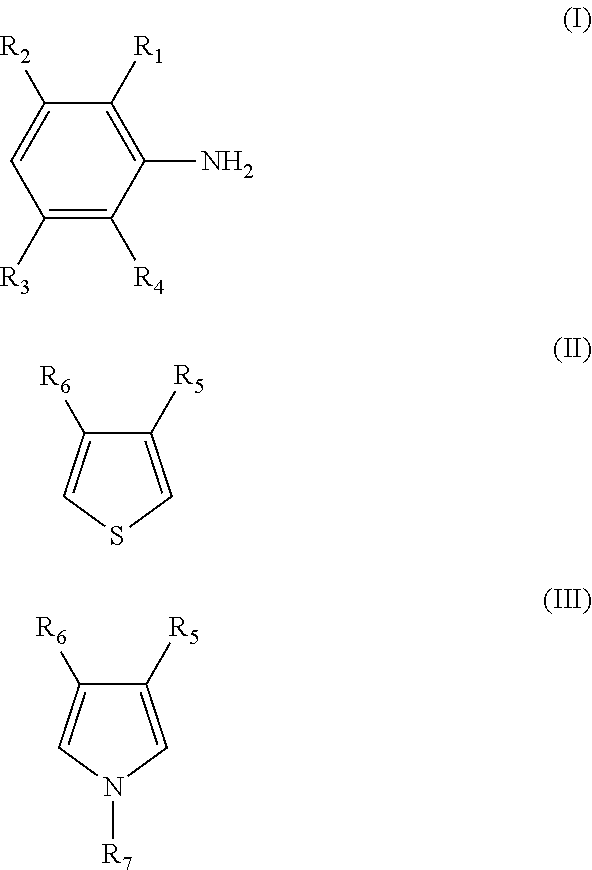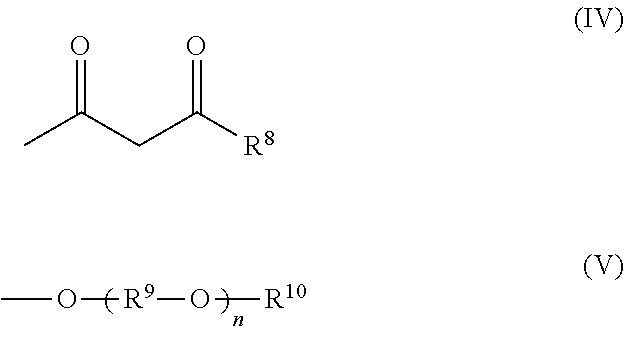Composition for Solid Electrolyte and Solar Cell Using the Same
a technology of solar cells and solid electrolytes, which is applied in the direction of electrolytic capacitors, non-conductive materials with dispersed conductive materials, material nanotechnology, etc., can solve the problems of ineffective oxidation-reduction function, inability to achieve sufficient oxidation-reduction function, and inability to essentially solve the problems of materials, etc., to achieve convenient and fast oxidation-reduction function, high stability, and convenient us
- Summary
- Abstract
- Description
- Claims
- Application Information
AI Technical Summary
Benefits of technology
Problems solved by technology
Method used
Image
Examples
embodiment 1
Composition for Solid Electrolyte of Embodiment 1
[0042]The composition for a solid electrolyte of the embodiment 1 comprises a polymer compound (A) and a carbon material. In the present specification, the “composition for a solid electrolyte of the embodiment 1” is also referred to simply as a “composition of the embodiment 1”. The polymer compound (A) is obtained by polymerizing a monomer (a) comprising a monomer (a-2) having chelating ability. When such a composition of the embodiment 1 is blended with a solvent, a solution in which the composition is homogeneously dispersed is usually formed. When the composition is blended with a solvent together with an ionic compound, aggregation hardly takes place because the interaction between the polymer (A) and an ion pair is relatively weak. That is to say, the solution obtained from the composition for a solid electrolyte of the embodiment 1 has high stability.
[0043]As the monomer (a) to prepare the polymer compound (A), only the monome...
embodiment 2
Composition for Solid Electrolyte of Embodiment 2
[0085]The composition for a solid electrolyte of the embodiment 2 comprises a polymer compound (A) and a π-conjugated polymer (β). In the present specification, the “composition for a solid electrolyte of the embodiment 2” is also referred to simply as a “composition of the embodiment 2”. The polymer compound (A) is obtained by polymerizing a monomer (a) comprising a monomer (a-2) having chelating ability. When such a composition of the embodiment 2 is blended with a solvent, a solution in which the composition is homogeneously dissolved or dispersed is usually formed. When the composition is blended with a solvent together with an ionic compound, aggregation hardly takes place because the interaction between the polymer (A) and an ion pair is relatively weak. That is to say, the solution obtained by the use of the composition for a solid electrolyte of the embodiment 2 has high stability.
[0086]The reason why aggregation is inhibited ...
embodiment 3
Composition for Solid Electrolyte of Embodiment 3
[0149]The composition of the embodiment 3 comprises a polymer compound (A) and a π-conjugated polymer (β). In other words, the composition of the embodiment (3) is a composition obtained by doping the π-conjugated polymer (β) with the polymer compound (A). In the present specification, the “composition obtained by doping the π-conjugated polymer (β) with the polymer compound (A)” is also referred to simply as a “π-conjugated polymer (β) doped with a polymer compound (A)” or a “doped π-conjugated polymer (β)”.
[0150]The π-conjugated polymer (β) doped with a polymer compound (A) as a dopant is prepared by polymerizing at least one monomer selected from monomers represented by the following formulas (I) to (III) in the presence of a polymer compound (A) and an oxidizing agent in an electrolytic solvent to form a π-conjugated polymer (β) and to simultaneously dope the π-conjugated polymer (β) with the polymer compound (A).
[0151]The polymer...
PUM
| Property | Measurement | Unit |
|---|---|---|
| pH | aaaaa | aaaaa |
| temperature | aaaaa | aaaaa |
| temperature | aaaaa | aaaaa |
Abstract
Description
Claims
Application Information
 Login to View More
Login to View More - R&D
- Intellectual Property
- Life Sciences
- Materials
- Tech Scout
- Unparalleled Data Quality
- Higher Quality Content
- 60% Fewer Hallucinations
Browse by: Latest US Patents, China's latest patents, Technical Efficacy Thesaurus, Application Domain, Technology Topic, Popular Technical Reports.
© 2025 PatSnap. All rights reserved.Legal|Privacy policy|Modern Slavery Act Transparency Statement|Sitemap|About US| Contact US: help@patsnap.com



